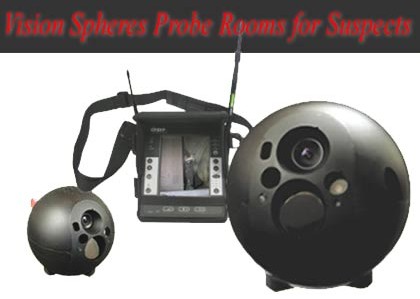Vision Spheres Probe Rooms for Suspects: Technological Solutions Meeting Counter-Terror Indoor Challenges
Science fiction motion pictures often describe robot sensors that can prawl building complexes indoor. But these robots are not purely fictitious imagnation. These animated Hollywood representations are based on real robotic technology which is in use today, or being evaluated for deployment in the near term. While ‘spider’ like mechanical creatures are operating only in rudimentary laboratory experiments, assault teams worldwide are already using indoor surveillance means utilizing ‘throw away’ sensors such as the Israeli Eyeball R1 or Swiss made Short Range Throwing Camera (SRTC) developed by Macroswiss.
The SRTC is a compact, rugged device that can be thrown into a potentially unsafe target area. Upon landing, the SRTC will self stabilize, perform a continuous rotational sweep and transmit live video. The operator viewing the video can slow down or reverse the rotation, or stop to monitor a particular point of interest.
More versions of similar devices include the French Spybowl from Exavision and the ScoutBall developed by U.S. based company Mobile Fusion that can see, hear and even smell its environment. A new concept recently endoresed by the British Ministry of Defence is the I-Ball, under development in the UK by the Scottish company Dreampact. These sphere shaped devices are designed to be rugged enough to be thrown or rolled into a scene, providing a clear, real-time view of the room interior. Rooms verified as cleared could be monitored by static unattended sensors, such as the UGS-Urban, developed by Textron Systems for the US Army Future Combat Systems program. These units comprise video, PIR and acoustic sensors that can be placed in a room or corridor, and report on any suspicious movement or activity in their vicinity. A similar concept is the Gatekeeper from ODF, providing wireless video and area surveillance indoors.
These vision spheres are proved as highly effective tools for manned assault teams operating indoors. But, what could be done in situations where entry into a building could doom the fate of the hostages or put the assault team at risk from explosives? In such circumstances. This task is the forte of the ‘Wall Penetrating Radar‘.
Our survey of current technologies assisting assault teams engaged in indoor combat covers the following aspects:
- Building Modeling – Remote Sensing Reveal Indoor layout, structures
- Vision Spheres Probe Rooms for Suspects
- Mini-Robots Operating Indoors
- Mini Robotic Multi-Purpose Platform


















